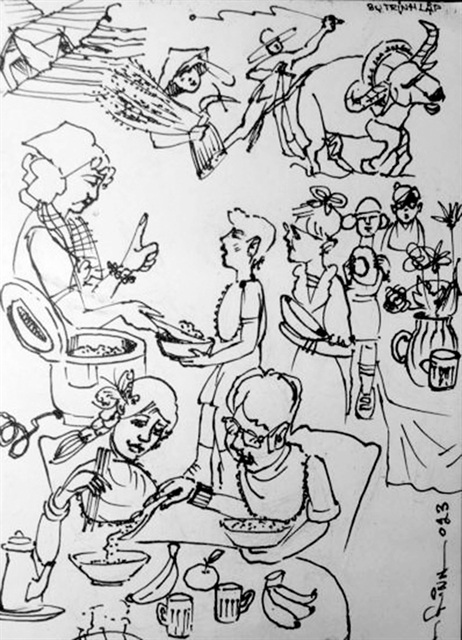 Talk Around Town
Talk Around Town

 |
| Illustration by Trịnh Lập |
by Nguyễn Mỹ Hà
The recent annual conference to review Việt Nam’s rice exports held by the Ministry of Industry and Trade projected that the country would export 6.6 million tonnes of rice this year.
In January, rice exports hit near 400,000 tonnes, with an average price of US$520 per tonne, earning nearly US$189 million. This amount of rice exported fell by 29 per cent in volume, but marked a 6.8 per cent increase in value, compared to January 2022.
Rice exports in January continued to dominate Việt Nam’s major markets. The Department of Planting under the Ministry of Agriculture reports that only rice planted in the Mekong Delta is for export. The rice production in the rest of the country is for domestic use.
This year, the Mekong Delta is expected to produce 24 million tonnes of rice, with domestic needs at 10.8 million tonnes only. The remainder shall be exported.
Elsewhere in the country, ensuring enough rice for local use is among the top concerns of local authorities. Not long ago, having enough rice to put on a family’s dining tray was still beyond the reach of many people.
Rice exports started in 1989 with a limited amount of 1.4 million tonnes. But this didn’t mean that domestic needs were met. In 1989, half of the population of Quảng Bình still lived in poverty, and in neighbouring Quảng Trị Province, more than 64 per cent were impoverished.
The latest records in 2022 show that the number of people living in poverty was around 5-6 per cent and this keeps going down but it is not eradicated yet.
Hunger is still vivid in the memory of those older than 50.
Writer Tạ Duy Anh recalled his own youthful dream of having a full bowl of steamed white rice, during a visit to a museum in Seoul: “For me and my fellow men and women, a bowl of white rice was always our dream!”
In an essay titled The White Rice Dream, he wrote: “I was captured by a 3D model of a bowl of white rice, looking as if it were real. It was so well-crafted, full like a little mound, with each and every rice grain looking so authentic and steamy, as if we could pick up a clump to eat.”
Anh became so obsessed with the bowl of rice, he went home to dig up on Korean recent history, only to find out that white rice once was a precious food served only to small children, the elderly and the sick.
“I sat there in my hotel room for hours, lost in thoughts about my youthful dream of having a freshly cooked full meal of white rice, to be eaten to my heart’s content with some roasted sesame and peanut salt, or better with a fish stew in soybean sauce or fish sauce," he wrote. ”The irony was that it was my dream and our generation's dream, yet we were farmers growing rice.”
In his youth, Anh was one of the excellent students who surpassed his peers to get into the only high school in a town of 20,000 people.
”My parents were so proud they spared me as much white rice as they could,” he wrote. “As a high schooler getting ready for the college exam, I always had to eat ahead of the family, and little did I know that every meal, my parents and my seven younger siblings had only enough to feed three.
“Don’t worry, son, have your meal first then go to school,” they said, which warmed my heart, but would torment me well into my adulthood.”
The growing body of a teenager craved food. Knowing that if he had more rice, his younger siblings would not have anything to eat, the young man only took two bowls.
“Today, when I tell my children that when my mother once gave me the luxury of having as many bowls of rice as I could, I finished six bowls in one sitting. It's true. Having two bowls then was like having nothing at all; I rode my bicycle to school, still thinking about the beautiful steamed white rice,” Anh said.
Young men saw their dream everywhere, when teachers cooked their meals at school, and on their way home smelling the rice being cooked from houses en route. They would even dream of finding a pot full of rice being kept warm under straw ashes.
At primary school, children learned about the preciousness of every grain of rice in sayings and poetry. But today, when people are not suffering from lack of food, they cannot understand.
As a saying goes: “Ai ơi bưng bát cơm đầy, dẻo thơm một hạt đắng cay muôn phần.” (roughly translated as "Anyone who holds a bowl full of rice in your hand, you should know that each soft fragrant grain of rice is borne from an enormous amount of hardship and bitterness."
It sounds dramatic, but it rings true, especially for those that have struggled with hunger.
As a country with more than 70 per cent of its population as farmers, we need to pay more care and attention, and respect the value of our staple food.
We have a coffee museum in Đắk Lắk Province, and so it stands to reason that we also need a rice museum to commemorate the most important food grain in Vietnamese life.
It’s about time we appreciated our country’s efforts to eradicate hunger, to keep control of national food security, and the nationwide determination to lift the country out of poverty. It's a struggle too important to forget. VNS




